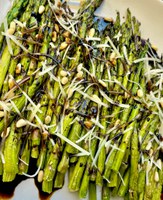Prairie Fare: Get Set for Grilling Season with 6 Questions
(Click an image below to view a high-resolution image that can be downloaded)
By Julie Garden-Robinson, food and nutrition specialist
NDSU Extension
At this time of year, enjoying warmer outdoor temperatures sometimes whets my appetite.
The aroma of grilling meat often wafts in my direction from a neighbor’s home as I check on the progress of my plants.
If you enjoy grilling food, some food safety considerations come into play as we move cooking and serving from indoors to outdoors. Foodborne illness cases tend to increase during summer months.
Try these six grilling questions based on U.S. Department of Agriculture recommendations. The answers are at the end of the article.
1. Which of the following can be grilled successfully? Select all that apply.
A. Apple slices
B. Watermelon wedges
C. Green peppers
D. Green beans
E. Peach halves
2. Grilling at home can lead to fires unless you take some precautions. List at least three ways to prevent fires when using any type of grill.
3. To what temperature should you cook ground turkey burgers?
A. 145 F
B. 155 F
C. 165 F
D. 175 F
E. 185 F
4. According to the USDA, what temperature is considered a “medium rare” steak?
A. 115 F
B. 125 F
C. 135 F
D. 145 F
E. 155 F
5. To what temperature should burgers made from ground beef be cooked?
A. 130 F
B. 140 F
C. 150 F
D. 160 F
E. 170 F
6. Using accurate tools is important, and food thermometers are an important food safety tool. When calibrating a thermometer for accuracy, fill a container with crushed ice and cold water to make an icy slush. What temperature should the thermometer gauge read? (Adjust the thermometer if possible following the manufacturer’s directions.)
A. 0 F
B. 5 F
C. 32 F
D. 37 F
E. 40 F
The answers:
- Any of those vegetables and fruits and many others can be grilled successfully. Search online for NDSU Extension and “Try Adding Some Fruits and Vegetables to Your Grilling Menu.”
- Be sure to pick a safe place to use your grill. It should be on a well-ventilated, flat, level surface away from overhangs, railings and shrubs. Keep a bucket of water and a fire extinguisher close at hand. If you use charcoal, allow the coals to cool completely for at least 48 hours in a noncombustible container. Do not put coals in a plastic trash can, for example.
- Cook poultry, including whole or ground turkey or chicken, to a minimum internal temperature of 165 F.
- Steaks, roasts and steaks from beef, pork, veal and lamb should reach 145 F to be “medium rare” or 160 F to be “medium.” These cuts of meat can be cooked to lower temperatures than ground meat.
- The USDA recommends that ground beef reaches an internal temperature of 160 F.
- The calibration temperature is 32 F based on the freezing point of water.
Add some color and flavor to your grilling menu with fruits, vegetables and a variety of protein sources. Remember these tips.
- Rinse fruits and vegetables and prepare for grilling. Remove the stems, seeds and cores from fruits and vegetables before grilling.
- When preparing whole fruits or vegetables, cut them into slices unless otherwise specified.
- Prepare bell peppers by cutting off the top and bottom of the pepper. Remove the core and then cut the pepper in half from top to bottom. This way, you end up with two flat rectangles that are grilled skin side down.
- When using skewers, choose vegetables and fruits of like thickness and water content. Cut them the same size to ensure even cooking.
- Use separate plates and utensils for raw meats and fruits or vegetables to prevent cross-contamination.
- Take your time and be patient. You may think you are burning something and remove it before it is done. Follow recipes and remember, grilling can be trial and error.
Here’s a springtime favorite to enjoy as a delicious side dish.
Roasted or Grilled Asparagus
1pound asparagus, fresh
1 cup balsamic vinegar
1 tablespoon olive oil
½ teaspoon salt
½ teaspoon pepper
½ cup pine nuts, toasted (or other nut such as almonds, optional)
½ cup parmesan cheese (optional)
Preheat oven to 425 F or grill. Break off the woody ends of the asparagus and place in a large bowl. Toss asparagus with olive oil to coat and season with salt and pepper. Spread the asparagus in a single layer on a roasting pan or grilling pan. Roast asparagus in the oven for ten minutes or about eight minutes on a grill until tender. While the asparagus is roasting, pour the balsamic vinegar in a small saucepan and bring to a boil over medium-high heat. Stirring constantly, cook the vinegar until reduced by half. Turn off the heat and set aside. Transfer the asparagus to a serving dish. Sprinkle with pine nuts and parmesan cheese. Drizzle balsamic vinegar over the asparagus and serve.
Makes four servings. Each serving has 84 calories, 4 grams (g) fat, 4 g protein, 7 g carbohydrates, 3 g fiber and 162 milligrams sodium.
(Julie Garden-Robinson, Ph.D., R.D., L.R.D., is a North Dakota State University Extension food and nutrition specialist and professor in the Department of Health, Nutrition and Exercise Sciences. Follow her on Twitter @jgardenrobinson)
NDSU Agriculture Communication – May 12, 2022
Source: Julie Garden-Robinson, 701-231-7187, julie.garden-robinson@ndsu.edu
Editor: Elizabeth Cronin, 701-231-5391, elizabeth.cronin@ndsu.edu




